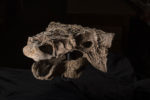
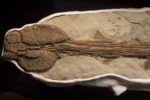 The skull and tail of the newly-discovered and awesomely-named Zuul crurivastator went on display at the Royal Ontario Museum in Canada earlier this year and I’m only finding about it now, consarnit. The exhibition opened in December of 2018 and closed in May and was a shin-smashing success.
The skull and tail of the newly-discovered and awesomely-named Zuul crurivastator went on display at the Royal Ontario Museum in Canada earlier this year and I’m only finding about it now, consarnit. The exhibition opened in December of 2018 and closed in May and was a shin-smashing success.
The fossil was discovered in the Judith River Formation on the outskirts of Havre, northern Montana, by accident on May 16th, 2014. A commercial fossil company came across it while removing rock overlying a 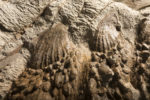 tyrannosaurid fossil. Because it had been buried beneath more than 40 feet of rock, it was an in exceptional state of preservation. It was raised in two blocks, skull and torso in one, tail in the other. The fossil company cleared the rock over a small portion of both sections before the specimen was acquired by the Royal Ontario Museum in 2016. Museum exports have been working to fully clear and study the fossil ever since.
tyrannosaurid fossil. Because it had been buried beneath more than 40 feet of rock, it was an in exceptional state of preservation. It was raised in two blocks, skull and torso in one, tail in the other. The fossil company cleared the rock over a small portion of both sections before the specimen was acquired by the Royal Ontario Museum in 2016. Museum exports have been working to fully clear and study the fossil ever since.
In 2017, they published the first paper announcing the discovery a previously unknown genus of dinosaur and naming it Zuul crurivastator, meaning “Zuul, destroyer of shins,” because paleontologists are a) awesome and b) know their Ghostbusters. Royal Ontario Museum paleontologist David Evans even called up Dan Akroyd, who turns out to be a big dinosaur buff, to get his buy-in. Akroyd approved heartily, as if anyone wouldn’t.
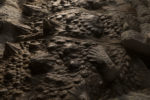 It is the most complete ankylosaurid (armored dinosaurs with mace-like tails) fossil ever found in North America, with its skull and tail club both intact and with preserved armature plates, soft tissues, skin impressions and dark films believed to be keratin. Skull and tail club almost never are found from a single specimen, and the level of soft tissue preservation gives paleontologists an unprecedented opportunity to learn more about the evolution of the animal’s skin and armor.
It is the most complete ankylosaurid (armored dinosaurs with mace-like tails) fossil ever found in North America, with its skull and tail club both intact and with preserved armature plates, soft tissues, skin impressions and dark films believed to be keratin. Skull and tail club almost never are found from a single specimen, and the level of soft tissue preservation gives paleontologists an unprecedented opportunity to learn more about the evolution of the animal’s skin and armor.
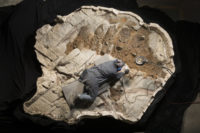 The team had a bit of a head start preparing the skull and tail which is why they were able to chisel away at much of the stone encasing them in a mere two years, but the belly and hips are still in a block of stone that weighs 15 tons. It will take years of applying tiny jackhammers to all that rock before the full fossil is ready for its close-up. The all-too-short exhibition of the head and tail helped the museum crowdfund financial support for this ambitious project that goes beyond the preparation and examination of the fossil to utilizing new technologies to explore its structure and surroundings.
The team had a bit of a head start preparing the skull and tail which is why they were able to chisel away at much of the stone encasing them in a mere two years, but the belly and hips are still in a block of stone that weighs 15 tons. It will take years of applying tiny jackhammers to all that rock before the full fossil is ready for its close-up. The all-too-short exhibition of the head and tail helped the museum crowdfund financial support for this ambitious project that goes beyond the preparation and examination of the fossil to utilizing new technologies to explore its structure and surroundings.
The incredible preservation of Zuul’s skeleton gives us the opportunity to use cutting-edge molecular palaeontology techniques to search for original proteins and other organic biomolecules in the soft tissue. We’ll also be using radiometric dating analyses to study the age of Zuul and the surrounding rocks, and will describe the other plants and animals from the quarry that lived in the same ecosystem as Zuul.